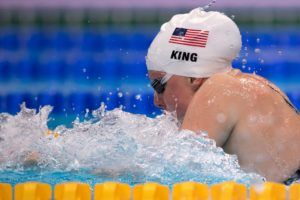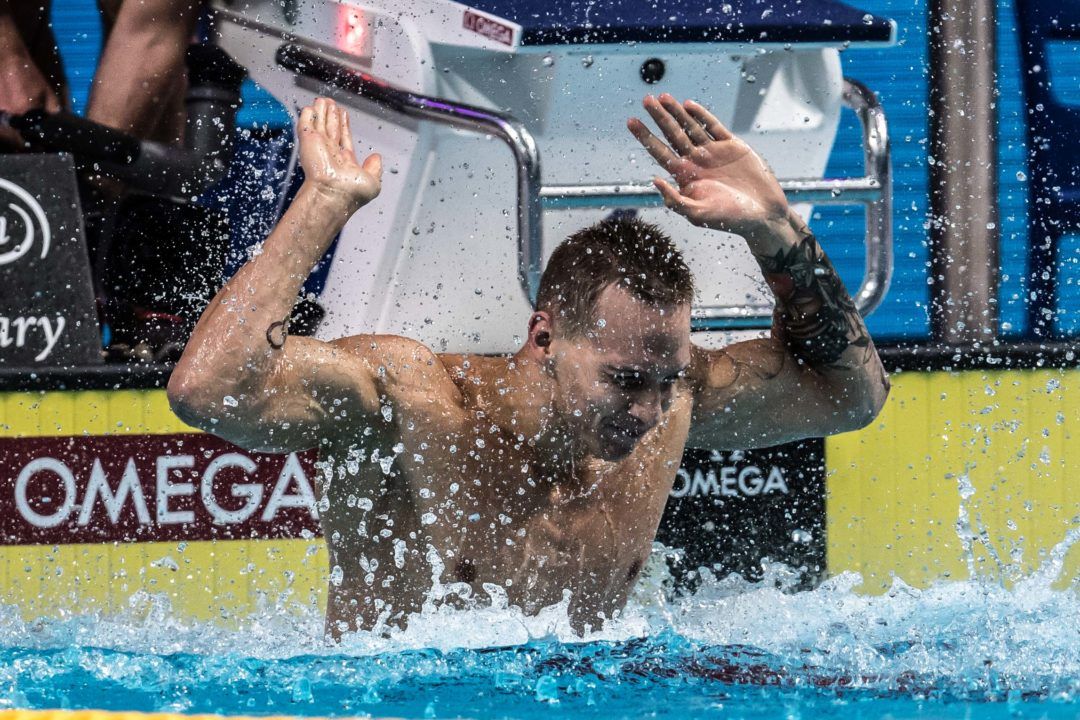TritonWear and Swim Swam partnered to bring you the best in swimming race analysis for the 2017 Fina World Championships. See all Fina World Championships race analysis from TritonWear here: http://www2.tritonwear.
The ever-exciting World Championships has come to a close. With many new records set and new players clutching key medals, it is a great opportunity for everyone to take a moment to understand just what went into all of these outstanding performances.
Throughout the week-long swimming portion of the event, TritonWear was busy analyzing the standout races each and every day. Using our technology, we were able to compile the data for these races to glean insights everyone can use when training next season. We did our best to get a cross section of different disciplines by different groups, so we could analyze as many different swimmers as possible, and provide learnings across all of the strokes. There were many lessons that cropped up time and time again, so we’ve compiled a list of the highlights here by category: selecting a race strategy, metric-specific a-ha moments, and tactics that worked well.
Strategy Selection

Sun Yang, 2017 World Championships Budapest, Hungary (photo: Mike Lewis)
The first thing that stood out was race strategy. Throughout the 8 days, and 9 races analyzed, we repeatedly saw completely contrasting strategies in the pool. It is important to note: every strategy requires a balance of stroke rate, speed and DPS, can shift throughout longer races, and is a very personal decision a coach and athlete must analyze carefully – all points we saw very clearly in the men’s 400 freestyle. When selecting a strategy, it is paramount to have the stamina both to support going out strong enough to stay with the frontrunners, and retaining enough energy to bring it home at the end, as we saw in the women’s 200 freestyle.
There were 3 distinct strategies we kept seeing. Some swimmers used a faster stroke rate, higher stroke count, and shorter DPS strategy. This worked well for those who had built substantial endurance, enabling them to have the energy to bring it home. It doesn’t natively carry speed though, so you have to be high energy to carry this strategy for anything longer than a 50m race. Swimmers using this strategy typically held their positions better, provided it was a considered strategy that played to their strengths. If considering this strategy, focus on maintaining endurance to sustain the stroke rate, knowing when to slow it down using stronger strokes, and balancing the speed with enough energy reserves for the burst to close the race.

Sarah Sjostrom wins the 50 freestyle at the 2017 World Championships Budapest, Hungary (photo: Mike Lewis)
The second strategy we saw was to utilize a slower stroke rate, lower stroke count, and a longer DPS. This approach allows the athlete to get more distance from each stroke, which in turn allows them to more easily generate speed for a better stroke efficiency, conserving energy. To use this strategy, an athlete must be able to maintain their stroke index throughout the race, or they will lose momentum. The key focal points of a longer, stronger strategy is being able to complement the slower stroke rate with an increased DPS to produce speed.
The third iteration was a combination of the first two, where the athletes would use mid-frequency, stronger yet still fast stroke style. This approach we saw mostly in the younger or less experienced swimmers, and typically finished in the middle to end of the field. It was less efficient than the longer stronger approach, but didn’t require quite the stamina of the faster shorter approach. Employing this strategy works best if you are in the midst of building either your endurance for a faster paced race, or your strength for a longer stroke swimming style.
Metric findings
With so many races analyzed, there was a ton of data to pull from — some of it contradictory — based on an athlete’s chosen strategy, paired with their skill level and natural swimming style.

Caeleb Dressel wins 100 fly at the 2017 World Championships Budapest, Hungary (photo: Mike Lewis)
First we looked at stroke efficiency, which is a measure of speed x distance per stroke, with a cycle multiplier applied (times 1 for breast and fly, and times 2 for free and back). The men’s and Women’s 100 fly showed us that the higher it is, the more energy is conserved throughout the race, enabling a strong finish. The women’s 100 fly also showed us that sometimes the most technically efficient stroke sometimes registers the slowest speed, when it’s not the right strategy for the athlete. Finally, we saw very clearly in the men’s 200 IM, during the backstroke, that the stroke index metric is useless if speed doesn’t compliment strong strokes.
When we look at speed, we saw again in the men’s 100 fly, that speed driven by a high DPS allows the athlete to conserve more energy for finishing power. We also recognized that sometimes it makes sense to lower the DPS slightly while increasing stroke rate to increase speed, again a revelation realized during the men’s 100 fly event.
Stroke count and DPS are all typically interrelated, so we will look at them as a group. First, we noted in the women’s 100 breast race that a strong stroke coupled with a good DPS is only valuable if the athlete is producing the speed to match. The men’s 400 freestyle showed us there is sometimes value in reducing DPS during a longer race, but when doing so you must increase stroke count in order to maintain the speed. The women’s 50 breast suggested that lowering stroke count while maintaining stroke rate increases efficiency.

Lilly King 2017 World Championships Budapest, Hungary (photo: Mike Lewis)
Stroke rate had more contradictory results, given it is a main factor in the opposing strategies at play throughout the week. During the women’s 100 fly the fastest stroke rate lacked speed. The women’s 100 breast race revealed a faster stroke rate can be helpful if an athlete is seeing lower returns in DPS. Several of the races highlighted that stroke rate increases must be accompanied by maintaining efficiency and DPS — or at the very least not dropping as much as competitors. Finally, the women’s 100 back suggested building or maintaining speed without increasing stroke rate to conserve energy, and the women’s 50 breast suggested that maintaining stroke rate while increasing DPS is key to increasing efficiency.
It’s well known that good starts, turns and finishes can make or break a race, so here are the findings to help perfect these components of a race. First, the women’s 100 fly and breast showed us that substantially longer under-waters can help compensate for a lower DPS, or help offset a fast stroke rate with slower speed. Spending more time underwater saves energy by reducing the need to increase stroke count throughout the length, as seen in the men’s 100 fly. It can also be said, by contrast, that shorter underwater times results in a higher stroke count, and thereby lower stroke efficiency — a point made clear in the women’s 50 breast race. Several athletes showed us the value of lengthening breakouts to conserve energy and lose less speed in freestyle, fly and back races alike.
Tactics that worked
 Throughout the 9 races analyzed, we repeatedly saw the same tactics being employed by the stars of the event. We saw many athletes get ahead by increasing their DPS and maintaining stroke count, while some were able to edge the competition by increasing their stroke count and maintaining speed. In the longer races the winners increased their speed through the middle lengths and maintained a high stroke count, to build a buffer between them and the rest of the field. In high-energy sprint races like the 100 fly we saw athletes taking more strokes in quicker succession, but offsetting this with efficient turns and starts. This allowed them to build more speed, and maintain efficiency. Finally, in the women’s 200 freestyle we saw Pellegrini overtake Ledecky by reducing her stroke rate, increasing her stroke count and maintaining power in DPS.
Throughout the 9 races analyzed, we repeatedly saw the same tactics being employed by the stars of the event. We saw many athletes get ahead by increasing their DPS and maintaining stroke count, while some were able to edge the competition by increasing their stroke count and maintaining speed. In the longer races the winners increased their speed through the middle lengths and maintained a high stroke count, to build a buffer between them and the rest of the field. In high-energy sprint races like the 100 fly we saw athletes taking more strokes in quicker succession, but offsetting this with efficient turns and starts. This allowed them to build more speed, and maintain efficiency. Finally, in the women’s 200 freestyle we saw Pellegrini overtake Ledecky by reducing her stroke rate, increasing her stroke count and maintaining power in DPS.
In summary, it’s clear that every athlete must carefully reflect on their personal metrics to determine the strategy which will best complement their unique strengths and weaknesses. Using a technology like TritonWear makes this task much simpler, as all the data is collected automatically and displayed in easy-to-interpret graphs and charts. Getting away from the manual collection of data allows coaches and athletes to spend more time focused on making improvements, as the areas of weakness are easily spotted by reflecting on data automatically collected over time. To learn more, contact Tritonwear at [email protected], follow on twitter or facebook @tritonwear, or instagram @tritonweartech. You can also subscribe to our newsletter to stay up to date on the latest news and information, visit tritonwear.com to subscribe.
SEE ALL FINA WORLD CHAMPIONSHIPS RACE ANALYSIS FROM TRITONWEAR HERE: HTTP://WWW2.TRITONWEAR.
VISIT THE TRITONWEAR HQ
LIKE TRITONWEAR ON FACEBOOK
FOLLOW TRITONWEAR ON TWITTER
Swimming analysis is courtesy of Tritonwear, a SwimSwam partner.

Good stuff. I particularly appreciated the section about time spent underwater. The telecasts never spotlight that enough. With promising new swimmers I always evaluate their upside partially based on whether or not they realize the tremendous benefit of delaying that first topside stroke.
Well there would be Some outliers..
Men 50 free: Dressel won the race on the start, but was not the fastest over the water
Men 50/100 Breast: On breast Peaty had a terrible start/UW/Turn but his Stroke Rate is off the charts
Men 1500: Paltrinieri probably had the worst DPS of all swimmers of the race, he went 40+ Strokes every 50 pool with almost no kick at all, but his streght to keep swimmer like that for 1500 meters is what gives him an edge, Romanchuk probably finished the race with something around 30% (Or more) less strokes than Paltrinieri
the only one that was faster over the water than Dressel was fratus. Everyone else seemed to be around the same or slightly slower.
yes , totally right
Peaty is such an anomaly because he looks like he is spinning but he is able to maintain the SR and his stroke integrity. Lilly King is the same way. Both require higher SR, which for breaststroke usually spells disaster at the end of the race, but these two are able to maintain it.
What is DPS?
Distance per stroke.
Distance per stroke
distance plus stroke
Damage per second
Dressels Per Start